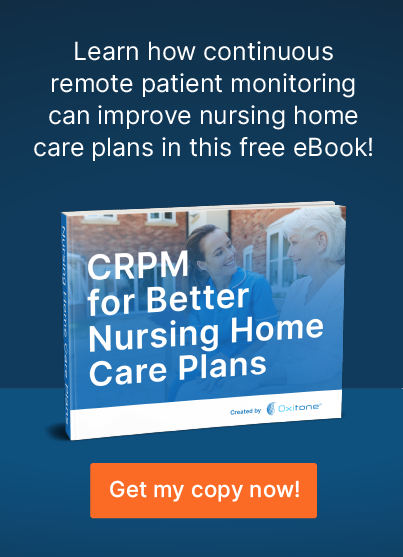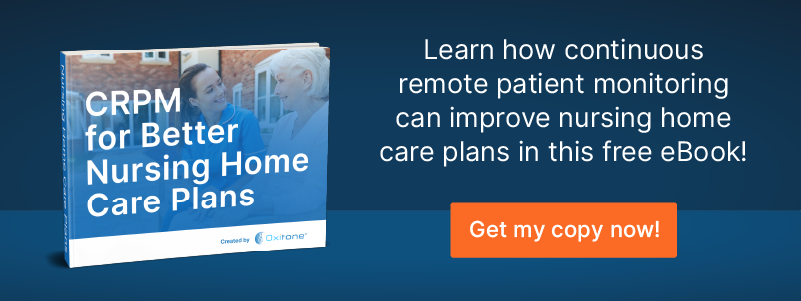Remote patient monitoring (RPM) engages technology to enable healthcare providers to observe varied metrics relating to a patient’s health on an ongoing basis while the patient is outside of the conventional clinical setting, such as at their home. In short, when using RPM, patient data is collected from a remote location and transmitted electronically to healthcare providers in another location for assessment.
RPM allows healthcare providers to track such patient data as heart rate, weight, activity, blood pressure, etc. It also facilitates the monitoring of chronic conditions, which would otherwise be costly (in repeated office visits) and could lead to unwanted physical, mental, and emotional stress for the patient.
Healthcare providers have found RPM to be particularly useful in the wake of the COVID-19 pandemic, which has necessitated the drastic limitation of contact between individuals. In situations where an excessive number of visits to healthcare facilities could actually increase the risk of exposure to the coronavirus pathogen in patients with comorbidities, RPM has eliminated most of that risk.
Limitations of Traditional RPM
Like any emerging or novel technology, however, there are pros and cons to utilizing these systems. Some of the limitations (or cons) of remote monitoring are minor issues that can be worked around by providers or addressed by IT departments.
Others, however, represent fundamental functional pitfalls that continue to plague medical facilities and healthcare providers.
Limited Accessibility
Reliable broadband connectivity is a must when implementing RPM, which makes doing so difficult for smaller healthcare facilities and those in rural or underserved areas. Economic considerations are often an issue in some of these facilities and even in urban areas that are otherwise well-served but may be operating under financial duress.
Also, not all patients have the technological means to support RPM on their end. Not everyone has a smartphone, there are patients who simply aren’t tech-savvy, and elderly or significantly infirm patients may face difficulties using the requisite technologies.
Lack of Patient and Provider “Buy-in”
According to a New England Journal of Medicine survey, RPM is one of the least effective patient engagement initiatives. Researchers have explained that the relatively low enthusiasm for RPM is due to the fact that wearables aren’t yet accessible for all patients, and that reliance—even in part—on patients to monitor and maintain equipment on their end makes many clinicians skittish. Some physicians have expressed concerns over the integrity (or accuracy) of retrieved data, and some patients have balked over security issues, i.e., the potential for their private health data to be intercepted by third parties and used for nefarious purposes.
Lack of Provider Engagement
In addition to provider skepticism and resistance to the unfamiliar, some clinicians also cite doubts that RPM technology will help increase patient accountability and prompt higher-risk patients to moderate high-risk behavior. Some physicians and clinics have also balked at the initial expenditure for implementing RPM, increased software requirements, and compatibility issues with electronic medical record systems.
Error Rates of Existing RPM Utilities
The reliability and accuracy of some wearable devices have also come into question among physicians, who have cited the fact that manufacturers provide little or no documentation to support said reliability and accuracy regarding their products. Many of these are reluctant to stake their reputations and patient health on devices for which error rates are unknown. A recent review in JAMA Dermatology showed that smartphone apps for melanoma detection have a 30% failure rate, and comparisons between various wearables showed large variations in accuracy between different devices, with error margins of up to 25%.
Not Being Real-Time Monitoring
Finally, there’s the hard fact that RPM is not real-time patient monitoring. Despite assumptions to the contrary, RPM represents episodic data collection (or episodic data capture). This means that an RPM device—wearable or otherwise—transmits data to the remote facility that is collected at specific times, intervals, or when specified events occur. This can be problematic because significant medical events can “slip through the cracks” during intervals in which the patient is effectively not being monitored. A patient who experiences a medical crisis during one of these intervals is on their own until the next designated data collection time point.
The Needs of Higher-Risk Patients
Remote patient monitoring has been touted as one of the most efficient available tools for chronic disease management. This includes patients with conditions like diabetes, heart failure, and chronic obstructive pulmonary disease. However, since RPM only provides episodic data collection, it cannot help to detect the early signs of chronic conditions worsening nor can it alert providers of a crisis in real time.
The top 5% of chronic patients account for 50% of annual care spending, which is about $50,000 per patient (Commonwealth Fund). Medical crises that arise with chronic patients often account for these expenditures, many of which could be headed off with real-time monitoring or addressed before the patient developed life-threatening complications.
The fact is that the available remote patient monitoring solutions produce incomplete patient data, leading to overburdened decision-making processes. What is needed to fill in the gap and accommodate higher-risk and chronic patients is a solution that can monitor a patient’s vital signs 24/7 and transmit the data to the healthcare provider in real time.
A New Generation in Remote Care
Enter the Oxitone platform. Oxitone has developed a full-suite, FDA-cleared solution that is true continuous remote patient monitoring (CRPM). With one click, clinicians can unlock patients’ real-time, intelligent insights and effortlessly follow up on hundreds of high-risk patients.
The Oxitone platform includes advanced, integrated SaaS, through which physicians can effortlessly enhance patient outcomes. Employing the data science of medical intelligence, Oxitone allows clinicians to classify patients into clearly-defined diagnostic categories and severities, while providing predictive trends and multi-parameter baseline variations.
On the patient side, there’s the wearable Oxitone 1000M, the world’s first FDA-cleared wrist-sensor pulse oximetry monitor. The device has a slim profile, is easy to use, supports Bluetooth, boasts a rechargeable long-life battery, and is CE Mark certified. Its vital parameters monitor provides data on the patient’s skin temperature, pulse rate and HRV, blood oxygen (SpO₂), motion and activity, sleep patterns, and more.
As far as reliability goes, the Oxitone 1000M has demonstrated superior accuracy and usability through the data derived for both FDA and CE clearance and numerous clinical pilots.
The Oxitone platform is a powerful, full-suite solution that addresses the needs of both lower- and higher-risk patients. Its real-time delivery of data makes it a superior patient solution to traditional RPM. Oxitone’s combination of AI’s predictive power with the convenience of wearable medical technology enables a clear definition of patient risk categories, speeds up care delivery, and accelerates access to care. By sparing no attention to detail—an imperative when considering the needs of higher-risk patients—Oxitone has positioned itself to be a leader in the transformation of chronic disease management.
Here at Oxitone, we boost value-based healthcare by delivering extraordinary patient, clinical, and economical outcomes at reduced medical utilization and cost. Patients need a prompt response to emergencies. Physicians need an easy and timely follow-up with patients. Our mission is to transform chronic disease management and help save lives worldwide.
Let’s save lives together! To see how we help remote patient monitoring companies and physicians improve the management and care of high-risk patients, contact us today!


